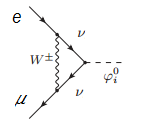Let's consider an extended version of the Standard Model (SM) with a new Yukawa operator of the form $$ \sum_\ell g_\ell\bar{\ell}\ell \phi ,$$ where $\ell$ is any lepton of the SM and $\phi$ is a new real spin-0 particle, which is assumed to be a singlet of $SU(2)_L$. This new term breaks the $SU(2)_L$ symmetry, but I'll not try to justify its existence.
Now, my question:
- I want to compute the loop correction to the vertex $\mu e\phi$, which does not exist in the original theory. One possible contribution for this term is show in the figure below (where I also suppose that neutrinos are massive). Does something guarantee that this loop computation will give a finite result in the framework presented here?
$\hspace{6.5cm}$ ,
,
- If this is not the case, what conditions must be imposed to the lagrangian in order to have finite contributions? Is it enough to have a Hamiltonian with dimension $d\leq4$ operators? Or is it essential to have a perfectly defined gauge theory?
